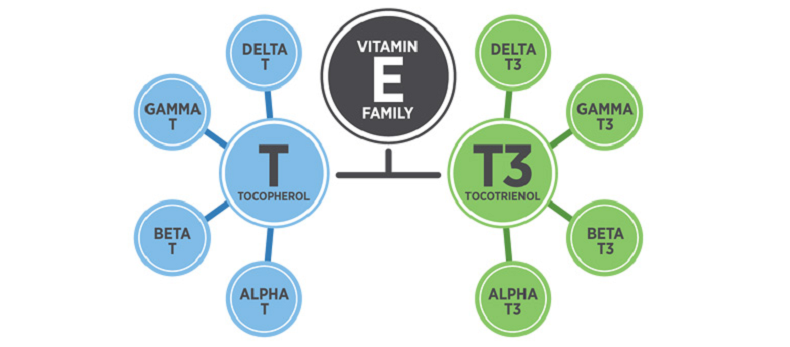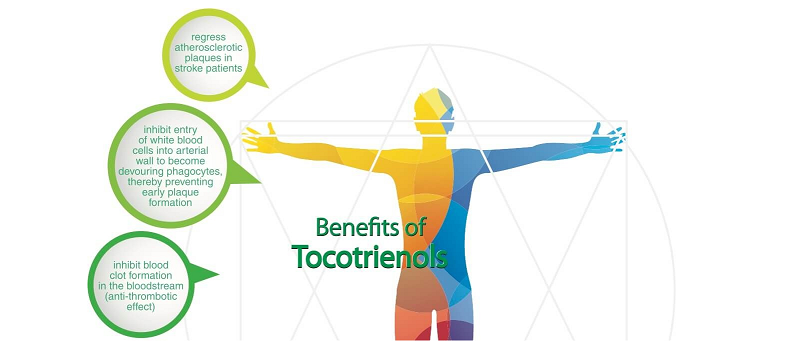
Often overshadowed by its more famous sibling, Tocopherols, Tocotrienols have been slowly gaining recognition in the scientific community for their significant health benefits. Though they represent only a small portion of the Vitamin E family, they’ve demonstrated remarkable antioxidant, anti-inflammatory, cardiovascular protective, neuroprotective, and even cancer-preventive properties.
Contents
Introduction to Vitamin E and Tocotrienols
Vitamins are fascinating molecules that play a critical role in our health. Our bodies can’t produce many of these vital nutrients, meaning we need to obtain them from our diet or supplementation. Among these essential nutrients, Vitamin E stands out due to its powerful antioxidant capabilities and integral role in numerous physiological functions. This potent vitamin, however, is not a single compound but a group of eight structurally similar molecules: four tocopherols and four tocotrienols.
Brief Introduction to Vitamins
Vitamins are organic compounds essential for normal metabolic functions. They contribute to a range of bodily processes, from supporting the immune system to assisting in the production of energy. They’re categorized into two types: fat-soluble (A, D, E, K) and water-soluble (B and C). Each has unique roles and is required in different amounts. Though they’re needed in relatively small quantities compared to macronutrients like proteins, fats, and carbohydrates, a deficiency can lead to serious health problems.
Overview of Vitamin E and its Components
Vitamin E, one of the four fat-soluble vitamins, is well-known for its antioxidant properties. It’s a collective name for eight different molecules: alpha, beta, gamma, and delta tocopherols, and alpha, beta, gamma, and delta tocotrienols. These compounds are found in a variety of foods, with the richest sources being plant oils, nuts, seeds, and green leafy vegetables. Of these, alpha-tocopherol is the most common and widely studied, often synonymous with Vitamin E in most literature.
Introduction to Tocotrienols
Tocotrienols, though less well-known than tocopherols, have recently begun to gain attention in the scientific community. Like tocopherols, they come in four forms — alpha, beta, gamma, and delta — but their molecular structure differs slightly. This difference allows them to offer a distinct set of health benefits. They’re less common in our diet but can be found in certain types of oils, grains, and nuts. Despite their relative obscurity, the potential health benefits of tocotrienols are remarkable, making them a topic worthy of exploration and understanding.

Understanding Tocotrienols
Before digging into the health benefits of tocotrienols, it’s crucial to understand what they are, how they compare with tocopherols, and where we can find them in our diet. A strong foundation of knowledge will enable us to better appreciate their unique contributions to our health.
Definition and Structure of Tocotrienols
Tocotrienols are members of the Vitamin E family, a group of fat-soluble compounds known for their antioxidant properties. They share a similar core structure with the tocopherols—both have a chromanol ring and a phytyl side chain. However, unlike tocopherols, which have a saturated side chain, tocotrienols have an unsaturated side chain. This slight structural difference not only sets them apart but also influences their physiological properties and health benefits [1].
Comparison of Tocotrienols and Tocopherols
Though tocopherols, specifically alpha-tocopherol, have traditionally received the most attention as the primary form of Vitamin E, emerging research suggests that tocotrienols may offer distinct and even superior health benefits.
Unlike tocopherols, tocotrienols are not as widespread in the plant kingdom. Their unsaturated side chain makes them more fluid, which enables them to distribute widely in cell membranes and provide more effective protection against free radical damage. Additionally, specific tocotrienols, particularly gamma and delta forms, have shown promising effects in areas such as neuroprotection and cholesterol regulation, which we will delve into further in the sections below [2].
Dietary Sources of Tocotrienols
Though not as commonly found in the typical Western diet as tocopherols, tocotrienols are present in a variety of foods. Palm oil and rice bran oil are particularly rich sources, while barley, oats, and certain types of nuts and seeds contain smaller amounts.
However, it’s worth noting that consuming these foods may not provide a significant amount of tocotrienols due to their relatively low concentrations and the influence of food processing and cooking methods. Therefore, for those interested in harnessing the full benefits of tocotrienols, supplementation might be a practical consideration.

The Health Benefits of Tocotrienols
Tocotrienols are no ordinary members of the Vitamin E family. While they share many of the health-promoting properties of their counterparts, the tocopherols, they also offer a unique set of benefits thanks to their distinct structure.
Antioxidant Properties
One of the most significant features of Vitamin E, including tocotrienols, is its potent antioxidant capabilities. Antioxidants are substances that neutralize harmful free radicals in our bodies, thereby helping to prevent cellular damage [3].
Role in Combating Oxidative Stress
Oxidative stress occurs when there is an imbalance between free radicals and antioxidants in your body. This imbalance can lead to cell and tissue damage and contribute to a variety of chronic diseases like heart disease, cancer, and Alzheimer’s. Tocotrienols can help combat this oxidative stress due to their antioxidant properties. They have the ability to neutralize free radicals, thereby preventing the potential damage these unstable molecules can cause.
Impact on Chronic Diseases
Research suggests that the antioxidant activity of tocotrienols could help protect against a range of chronic diseases. For instance, studies have indicated that tocotrienols can reduce the risk of heart disease by preventing the oxidation of LDL cholesterol, a key factor in the development of atherosclerosis. Similarly, their ability to counteract oxidative stress may help lower the risk of certain types of cancer and neurodegenerative diseases.
Anti-Inflammatory Effects
In addition to their antioxidant capabilities, tocotrienols also possess significant anti-inflammatory properties, which can further contribute to disease prevention and overall health [4].
Mechanisms of Anti-Inflammatory Actions
Inflammation is a natural response of your immune system to injury or illness. However, chronic inflammation can damage healthy cells, tissues, and organs, leading to various health issues, including heart disease, diabetes, and cancer. Tocotrienols can counteract this harmful process by modulating the activities of specific enzymes and proteins that trigger inflammatory responses.
Potential Implications for Health
The anti-inflammatory effects of tocotrienols could potentially benefit those with conditions associated with chronic inflammation, such as arthritis, asthma, and inflammatory bowel disease. More research is needed in this area, but the existing evidence is promising.
Cardiovascular Health
Tocotrienols have demonstrated significant benefits for cardiovascular health, particularly in reducing cholesterol levels and preventing atherosclerosis [5].
Reduction of Cholesterol Levels
Several studies have shown that tocotrienols, particularly those derived from palm oil and rice bran oil, can help lower cholesterol levels. They do this by inhibiting an enzyme called HMG-CoA reductase, which plays a key role in cholesterol production in the liver. By inhibiting this enzyme, tocotrienols can help regulate cholesterol synthesis and maintain healthy cholesterol levels.
Prevention of Atherosclerosis
Atherosclerosis is a condition characterized by the hardening and narrowing of the arteries due to the buildup of plaque, consisting primarily of cholesterol. Tocotrienols can help prevent this condition not only by lowering cholesterol levels but also by reducing inflammation and oxidative stress, two critical factors in the development of atherosclerosis.
Neuroprotective Benefits
Emerging research suggests that tocotrienols could have neuroprotective effects, offering potential benefits for neurodegenerative diseases and stroke recovery [6].
Role in Neurodegenerative Diseases
Neurodegenerative diseases, such as Alzheimer’s and Parkinson’s, are often associated with oxidative stress and inflammation. As we’ve already established, tocotrienols can combat both these processes, suggesting their potential in preventing or slowing down these diseases. Some studies have also indicated that tocotrienols can help prevent neuronal cell death, a hallmark of neurodegenerative diseases.
Tocotrienols and Stroke Recovery
In addition to their potential role in neurodegenerative diseases, tocotrienols may also aid in stroke recovery. They have been shown to reduce the size of stroke-related lesions and improve functional outcome in experimental models. While more human studies are needed, these findings highlight the potential of tocotrienols in neuroprotection.

Cancer-Preventive Effects
Tocotrienols could play a role in cancer prevention due to their ability to inhibit cancer cell growth and induce apoptosis [7].
Inhibition of Cancer Cell Growth
Various studies have shown that tocotrienols can inhibit the growth of various types of cancer cells, including those of breast, prostate, lung, and colon cancers. They do this by interfering with several pathways that promote cancer cell proliferation.
Role in Apoptosis
Apoptosis, or programmed cell death, is a process that eliminates damaged or unnecessary cells. When this process malfunctions, it can contribute to the development of cancer. Tocotrienols can help induce apoptosis in cancer cells, thereby preventing the unchecked cell growth characteristic of cancer.
Skin Health Benefits
Finally, tocotrienols can contribute to skin health by offering photoprotection, anti-aging effects, and aiding in wound healing [8].
Photoprotection and Anti-Aging Effects
Exposure to ultraviolet (UV) radiation from the sun can cause skin damage, leading to premature aging and increasing the risk of skin cancer. As potent antioxidants, tocotrienols can help protect the skin from this damage by neutralizing the harmful free radicals generated by UV radiation. Additionally, their anti-inflammatory properties can help soothe skin inflammation caused by sun exposure.
Role in Wound Healing
Tocotrienols may also have a role in wound healing. They’ve been shown to promote the proliferation of skin cells and the synthesis of collagen, a protein essential for skin strength and elasticity. This suggests that tocotrienols could potentially aid in wound healing and skin repair.
The Optimal Intake of Tocotrienols
While we’ve highlighted the potential health benefits of tocotrienols, it’s also essential to understand how much we need and any potential side effects that could occur with their intake. Understanding this will ensure we can safely and effectively incorporate these compounds into our health regimen.
Recommended Dosage for Health Benefits
There’s currently no established recommended daily allowance (RDA) specifically for tocotrienols. Most research studies investigating the health benefits of tocotrienols have used supplements providing between 100 mg to 800 mg per day.
It’s important to note that while tocotrienols are a component of Vitamin E, their supplementation does not replace the need for an adequate intake of the other components, especially tocopherols. The recommended daily allowance for vitamin E in general, including both tocopherols and tocotrienols, is 15 milligrams (or approximately 22.4 IU) for adults.
Given the lack of a specific RDA for tocotrienols, it’s advisable to consult a healthcare provider before beginning any supplementation regimen.
Possible Side Effects and Interactions
Tocotrienols are generally considered safe for most people when taken in appropriate amounts. However, as with any supplement, there can be potential side effects and interactions with other medications.
Potential side effects are rare but may include mild gastrointestinal symptoms such as nausea, diarrhea, or stomach cramps. High doses of any form of Vitamin E, including tocotrienols, can also potentially interfere with the action of anticoagulant drugs (blood thinners), increasing the risk of bleeding.
References
[1] What you need to know about tocotrienols
[2] The Next Generation Vitamin E How Tocotrienols Benefit the Heart, Brain and Liver
[3] Pharmacological potential of tocotrienols: a review
[4] What Are Tocotrienols?
[5] Tocotrienols
[6] Giving Tortilla Chips a Vitamin E Boost
[7] The Potential of Tocotrienols to Mitigate the Effects of Chronic Obstructive Pulmonary Disease
[8] Tocotrienols






